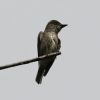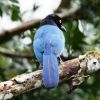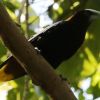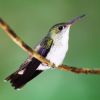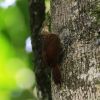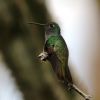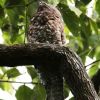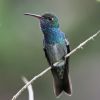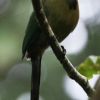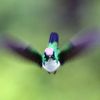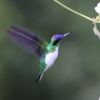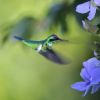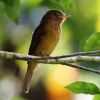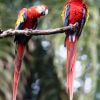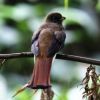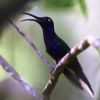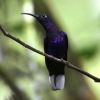Itinerary
Day1
Start from London, Heathrow in the morning with a direct flight to Georgetown, Grand Cayman with a refuelling stop at Bahamas. Arrive early evening to Georgetown. Transfer to the hotel.
Day2
Full day discovery of the Grand Cayman which is a good place to start to know the Caribbean birds. We start with a morning birding at the Mastic Reserve. We bird alongside a short two-mile stretch trail which crosses a wide variety of different habitats, mainly Caribbean's dry, subtropical forest giving us a good picture about the original ecosystem in the Cayman Islands. We pass through a bit of grassy savannah, but most of the area is an interesting mix of a black mangrove swamp and a dry forest with some rocky areas. Most of these types of habitats have been victims of particularly intense deforestation in the whole Caribbean area. But here we have a unique chance to cross Grand Cayman's wild interior which has been left virtually undisturbed for a long time. Beside several species of butterflies, lizards, snakes, frogs & large hermit crabs we should find some good bird species as well. Among the birds one of the highlights we will look for is the Stripe-headed Tanager (or Western Spindalis) and Cuban Bullfinch. We should be able to observe some migrating Warblers and Vireos as well. We will also look for Caribbean Dove which loves undisturbed areas. West Indian Woodpecker should be common. At the black mangrove we should find some of the mastic trees from which the Mastic Trail got its name. Some of these trees are black while others yellow, but all have interesting veins on its self-peeling bark. During our walk we will reach the highest point in Grand Cayman, a hill, locally caled "The Mountain", with its towering height of 18meters or 60 feet! :-) During an optional evening walk we might find an Antillean Nighthawk as well.
Day3
After breakfast we have some time to enjoy the Caribbean a bit more before we leave the hotel and get back to the airport before noon to catch our flight to La Ceiba, Honduras where we arrive early afternoon after a short, less than 1 and a half hour flight. From La Ceiba first we travel West more or less parallel with the seaside and later we turn South towards the middle part of the country.
During the afternoon we drive up to the Cerro Azul National Park which protects huge tracts of rainforest and cloud forest. We stay 3 nights at this superb place. Not just views are breathtaking, but its forests boast one of the highest levels of biodiversity in the country. Imagine a huge area where more than 85% is covered by primary forest. Just from our accommodation there are plenty of trails starting to different directions, each offering great tropical forest birding.
Sometimes Black-crested Coquette is really close to our accommodation, while Green-breasted Mountain Gem can be found at the flowering bushes nearby the restaurant area. It is quite easy to find Keel-billed Toucan and also the noisy, but colourful Green Jay when it is around. Much more challenging species include Keel-billed Motmot, Black-faced Ant-thrush, Tawny-throated Leaftosser or Slate-coloured Solitaire. Nigh at Cerro Azul.
Day4
Today we spend the full day birding on site at Cerro Azul. We might start early morning with a few minute drive down to a dam. We have a good chance for Grey Hawk and even Collared Forest-Falcon here. Cattle Egret, Killdeer, Little Blue Heron, Black-crowned Night Heron are typical birds here, but we had Sungrebe swimming across the lake as well.
We check an area for Prevot’s Ground Sparrow – this is a different race that you might have seen before in Costa Rica! The trail leading there and the area can yield Spot-breasted Wren, Green Backed Sparrow, Rufous-browed Peppershrike, Greyish Saltator, several different Warblers, like Yellow, Chestnut-capped and Chestnut-sided.
In the morning Red-lored Amazons and Olive-throated Parakeets fly out to find good feeding areas. Both Summer, Passerini’s & Crimson-collared Tanagers are present. Brown Jays alarm from time to time. Other species to mention include Grey Catbird, Masked Tytira, Woodtrush. Beside White-tipped Dove with great luck we might find a Ruddy Quail Dove as well. Ant-specialists include Red-throated Ant-tanager, Barred Antshrike & Dusky Antbird, while Flycatchers will be represented by Dusky-capped Flycatcher and Bright-rumped Attila. Balck & White and Magnolia Warblers, plus Buff-throated Saltators are quite common, but we might find Turquoise-browed Motmot and Blue-winged Warbler as well. We should check the tree-trunks for Barred Woodcreeper, Olivaceous Piculet and Lineated Woodpecker. Both Orchard Oriole and Spot-breasted Oriole should be around. A bit harder to spot White-breasted Wood-wren or White-collared Manakin, but we try our best. We check a place for Ruddy Crake alongside the road as well.
Before lunch we take one of the trails, perhaps the one which goes down to a cascade. Both Louisiana and Northern Watertrush should be around offering a great opportunity to compare the two species. It is not an easy walk, but we will take our time and will be energized regularly by new exciting sightings such as White-collared Manakin, Violaceous/Gartered Trogon, Black headed Trogon, Rose-throated Becard, Boat-billed Flycatcher and a number of Woodcreepers such as Tawny-winged, Ivory-billed, Olivaceous & Barred. Tree-trunks and branches are worth to check for other species as well, such as Golden-olive & Smoky Brown Woodpeckers..
After this hike we refresh ourselves and have a lunch. After lunch in the late afternoon we can spend some time with checking out the Humminbird feeders where we should have the following species: Violet Sabrewing, White-bellied Emerald, Rufous-tailed Hummingbird, Long-billed & Little Hermit, Green-fronted Mountain Gem. Yellow-bellied Tyrannulet, Lesser Greenlet, Northern Bentbill, Olive-sided Flycatcher and Squirrel Cuckoo is usually around as well, but sometimes even here we can find the beautiful Keel-billed Motmot
If we still have energy we might take another loop trail where there are different new platforms and lookout towers to observe birds & other wildlife. Nigh at Cerro Azul.
Day5
We start early with breakfast and then drive to Santa Barbara National Park which is about an hour away. The place we visit is considered one of the best cloud forest birding areas around Lake Yojoa. It is surely an amazing birding destination with over 300 species recorded during the years.
The forest has some special species like the magnificent Resplendent Quetzal or the hard to find Buffy-crowned Wood-partridge. Bushy-crested Jay, Emerald Toucanet or Blue and White Mockingbird are relatively common. The more open areas offer terrific birding opportunities for other species, such as various hummingbirds and tanagers, including the beautiful Blue-crowned Hummingbird, Flame-coloured Tanager and Wine-throated Hummingbird.
As we return to Cerro Azul we will stop and bird areas where we try to find any of those species which we missed yesterday. Nigh at Cerro Azul
Day6
Today we start with a birding at the lowlands of Cerro Azul and Lake Yojoa. If you interested we might stop at the famous Pulhapanzak Waterfall and then continue with birding around Lake Yojoa first. There are several Snail Kites hunting for large-sized snails, while big group of ducks and waders should be around as well. Beside checking Egrets & Herons we should keep an eye on the dense vegetation for Ruddy Crake. The surrounding flowering bushes and trees offer great feeding tables for several songbirds, including hummingbirds as well. Also we might visit an interesting boardwalk through mature wet forest full with various birds. We will also enjoy a great lunch at a lake-shore restaurant where we will be surrounded by birds.
Later we have a long journey to the North with some short stops and we finish our day at our next, new base at the foot of the Pico Bonito where we stay at the superb lodge of Honduras for 4 nights.
Pico Bonito National Park protects one of Central America’s largest unexplored rainforests. It is a real jewel of Central America’s Caribbean coast with a huge variety of tropical amphibians and exotic mammals such as kinkajous, peccaries, coatis, monkeys, tayras and even cats like margay, puma or jaguar. What is more it is home to over 420 species of birds, including stunning Tanagers, colourful Orioles, Motmots, Jays, Hummingbirds, Tinamous and many other. First night at Pico Bonito.
Day7
Today we spend the whole day in the gardens and on the trails of Pico Bonito Lodge. The lodge has 400 acres of tropical wilderness with two roaring rivers with miles of private trails between them. Spectacular waterfalls, lush gardens with brilliant flora and fauna and breathtaking views – that is what this place can offer. It is quite an incredible place where without making long hikes you can enjoy fantastic species even from a comfortable armchair at the landscaped pool. But if you make a short walk to a lookout tower from there you can see not just the panoramic view of the Pico Bonito Hill, but last time at each visit of the tower after scanning a bit we found at least one Lovely Cotinga; and we did this almost every day at different times! No wonder this is one of the best destinations with the most comfortable and enjoyable birding in Honduras!
So it is impossible to list all the birds what a full day birding at Pico Bonito trails and gardens can produce, but here we mention at least a few: Little Hermit, Violet-headed Hummingbird and Violet-crowned Woodnymph regularly visits the flowery bushes, Turquoise-browed & Blue-crowned Motmot is usually in the garden. Sometimes even Scarlet-rumped Tanager is around.
During the walks we should find Black-cowled Oriole, Black-faced Grosbeak and small groups of Collared Aracari.
For White-collared Manakin or Slaty-tailed Trogon we have to go further, visiting one the trails. We regularly find Tody Motmot alongside one of the trails. But more you go, higher the chance to find the even more secretive ones, such as Highland Guan, Tawny-faced Quail or Scaly-throated Leaftosser.
Day8
Today we travel a short distance to Rio Santiago area, another private land at the foot of the Pico Bonito Hill where first we make a short hike and after that we rest at a shady terrace surrounded by dozens of Hummingbird feeders.
The hike can produce Olive-backed Euphonia, Green Honeycreeper, various warblers and gives a second chance for Keel-billed Motmot. Another rare species which indicates a good quality habitat is Rufous Morner.
By the time we finish the walk with the more heat and sunshine the hummingbird feeders will be extremely busy. Beside the common species there are always special ones to look for. The following list is species we saw last time here: Violet Sabrewing, White-necked Jacobin, Purple-crowned Fairy, Stripe-throated and Long-billed Hermit, Band-tailed Barbthroat, Scaly-breasted & Rufous-tailed Hummingbird.
Finally we go back to have our excellent lunch at Pico Bonito and later in the afternoon we bird in the garden. We also can revisit the lookout tower. It has happened here once that as we finished counting the flying over White-chinned Swifts we looked down and witness a Tayra disappearing among the branches. Montezuma and Chestnut-headed Oropendulas should be around as well.
There is also a Serpentarium to visit for those who are interested in reptiles and amphibians. The lodge offers an optional night tour as well during which you can see several different tropical frogs, spiders, scorpions, snakes, basilisks and more.
Alternatively in one of the evenings we can search Little Tinamou, which visits the gardens. This is also the time when we should try to find a Great Potoo as well.
Day9
From our base within an hour drive we can arrive to the nearby famous botanical garden of Honduras. The Lancetilla Botanical Garden is actually one of the largest tropical gardens in the world. It is partly the original tropical forest and partly mature and mixed plantations of tropical vegetation from all over the world. This protected nature reserve is not just home to a wide variety of trees, but also to over 300 species of birds, including toucans, tanagers, orioles, trogons, motmots, antbirds, a variety of colourful parrots and many more. Without trying to make a full list here we just mention a few species we got on our last tour here just during one morning: Blue-black Groesbeak is quite common, such as Groove-billed Ani, but soon we find Black-headed Trogon and not much later Violaceous Trogon as well. A flash of amazing colour reveals Passerini’s Tanager, but Collared Aracaris and Keel-billed Toucans immediately trying to steal the show. High in the canopy Masked Tytira making its strange calls not too far from a Baltimore Oriole & a Rose-throated Becard. By checking the aging, moss-covered tree-trunks we should find both Cocoa and Streak-headed Woodcreepers, but Chestnut-headed Woodpecker is also a nice surprise. Great Ant-shrike can be very vocal. As a Grey Hawk flies across makes some of the Blue Ground-doves panicking. But a much bigger alarm is caused by a Ferruginous Pygmy Owl call which collects dozens of species to one area. The crowd includes Long-billed Gnatwren, Summer Tanager, Olive-backed Euphonia, Orange-billed Sparrow, Tawny-crowned & Lesser Kinglet, Long-tailed Hermit, Worm-eating Warbler, Grey Catbird, Yellow-bellied Tyrannulet, Ochre-bellied Flycatcher and Red-throated Ant-tanager. Not bad for a short stop!
After the morning birding when we start to feel a bit tired and hungry we go back to Tela to have a nice lunch with a refreshing Caribbean breeze. But Lancetilla offers such a fantastic birding with great diversity that soon we will dream about to return. So no wonder we will spend the whole day there discovering the several well- maintained trails which offer easy walking and birding along the way. So during the afternoon we discover what more the Botanical Garden can offer, such as Rufous-tailed-, Stripe-tailed and Scaly breasted Hummingbird, the smashing Blue-crowned Motmot or the secretive Slaty-breasted Tinamou. Chestnut-headed Oropendulas move in the canopy in small groups. We have a good chance for Rufous-tailed Jacamar as well, but a really hard to get bird is Thrushlike Schiffornis, which last time we not just heard and seen, but even took some great pictures as well. Finally we return back to our lodge in the same way and prepare for our last excellent dinner there.
Day10
Today is our last morning at this lovely place, so after breakfast we can bird in the garden and at the Pico Bonito trails, trying to find any of the previously missed species. Also a final lookout from the tower can fit in to check how many Lovely Cotingas we can see on the last day?! You can also enjoy the amenities at the lodge and finally we have to say goodbye reluctantly to this enigmatic place. After an early lunch we have a short transfer to the La Ceiba Airport. We have a short flight back to the Grand Cayman island, arriving in the afternoon. We check in our hotel and meet for a dinner.
Day11
Today we have another almost full day to discover what the Cayman Islands can offer.
You can have a leisurely day relaxing before the evening flight home or we can look around for some more local birds. We should find some of the colourful Grand Cayman Parrots which still inhabit the island in good numbers. A walk along the shore can produce Black-bellied and Semipalmated Plovers, Greater and Lesser Yellowlegs, Willet, Whimbrel and the ever-present small groups of Ruddy Turnstones beside a lonely Spotted Sandpiper. Laughing Gull, Royal and Least Tern should be in the air, sometimes mobbed by a Magnificent Frigatebird.
Optional visit to Queen Elizabeth ll Botanic Park and learning about the Blue Iguana programme can be arranged as well. Our flight departure will be in the evening to London.
Day12
Overnight flight, arrive to London before noon.
It is also possible to stay extra nights at Pico Bonito, please ask for special price!


































